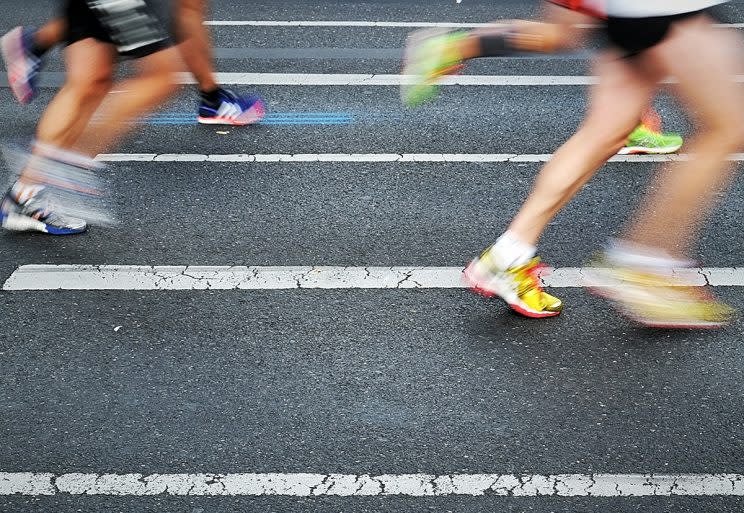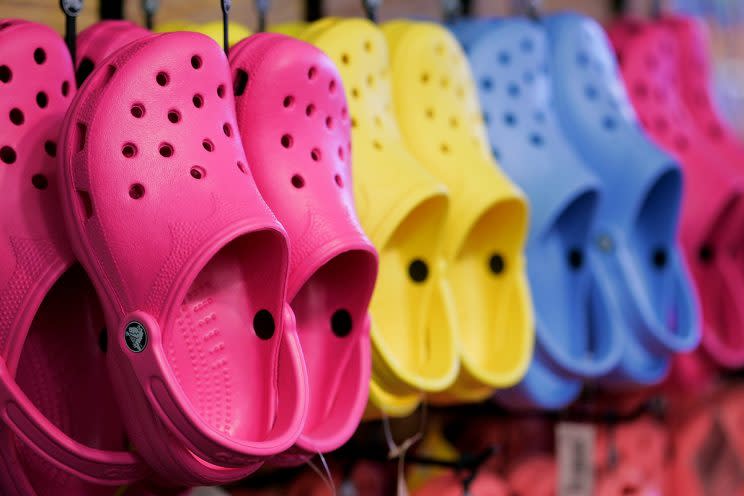A Father and Son Wore Crocs to Run a Half-Marathon

A teenager named Benjamin Pachev may have finished in the top 20 of a popular half-marathon in Indianapolis on Saturday, but it’s his footwear that’s getting the most attention: Pachev, 18, ran the race in a pair of Crocs.
Pachev’s father, software engineer Sasha Pachev, also ran the race in Crocs — $20 classics, the same style his son wore — and tells the Indianapolis Star that he accidentally discovered Crocs worked well as running shoes.
Sasha says he and his wife run with their older children six days a week and that, one day in 2009, the kids refused to change out of their Crocs. “I said, ‘OK, let’s see how it goes,’” he recounted. “And they ran, at fast speeds, and I could tell their form was better in Crocs. It looks more natural. I said maybe there’s something to it.”
Sasha ended up trying it out himself and found that the slingback clogs, which have a loose fit, didn’t fall off. “I really liked the feeling, and I’ve run in them ever since,” he said. “They’re really not that much different, speedwise, from racing flats.”

Sasha, who finished 44th out of 20,000 people in the race (his son finished 16th), likens running in Crocs to running barefoot, or in Vibram FiveFinger shoes. “They basically feel like you’re running barefoot on grass, except you’re doing it on asphalt and you’re not losing the speed,” he said. “It’s a very good feeling.”
Sasha says his family finds the cheapest Crocs on Amazon. “I grew up running in Moscow. We didn’t have the luxury of having the fanciest shoes,” he said. “We ran in basketball shoes or whatever we could find. We developed resilience, and we don’t need special running shoes.”
The dad acknowledges that his footwear looks weird to other runners, and says that he and his family are used to the comments. “They normally go, ‘Who’s this idiot running in Crocs, and why are they keeping up with me?’” he said. But Sasha says they last longer than typical running shoes and that he’s never gotten a blister while wearing them.
Running in Crocs may sound bad for your feet, but experts say it’s not as terrible as you’d think. “I can’t say it’s necessarily a bad thing, but it’s not for everyone across the board,” Ken Jung, MD, a foot and ankle surgeon at Kerlan-Jobe Orthopedic Clinic in Los Angeles, tells Yahoo Style.
John-Paul Rue, MD, a board-certified orthopedic sports medicine surgeon with Mercy Medical Center in Baltimore, agrees. He tells Yahoo Style that the basic principle of footwear is to protect your feet from things like rocks, turf, and road. “If you have shoes that protect you from that, you should be OK,” he says, pointing out that “people have been running barefoot for a long time.”
Michael Jonesco, a sports-medicine physician at the Ohio State University Wexner Medical Center, tells Yahoo Style that there’s no strong, convincing scientific evidence that shoes alone will prevent or cause injuries, which is why he doesn’t tell his patients what type of shoe they should wear. “Shoes should be comfortable, fit well, and be something that the runner feels confident in,” he says. And if it works for the Pachevs, he says, he’s fairly OK with that.
But Brian Grawe, MD, an orthopedic surgeon and an assistant professor at the University of Cincinnati College of Medicine, Department of Orthopedic Surgery and Sports Medicine, tells Yahoo Style that it depends on how much mileage a person is doing. “Ultimately, a person is not going to have too much of a risk of injury if they keep their mileage under three miles or so a day,” he says. “But for the serious runner who runs up to 100 miles a week, I get concerned about the risk of injury in comparison with somebody with a stability type shoe.”
Jon Divine, MD, a professor of orthopedics and sports medicine at the University of Cincinnati, tells Yahoo Style that he also has some concerns. “This type of shoe would offer very little effective shock absorption for someone running and exposing the body to at least three to four times body weight worth of force to the foot with each step,” he says. “There is little internal padding, so friction is going to create skin blistering.” And with a less resistant sole than a running shoe, Crocs have an increased risk of slipping on wet or slippery surfaces like traffic lines on a street or wet grass, he says.
The way someone starts running in Crocs may make a difference too. Mary Thiel, clinic manager and physical therapist at Michigan State University Rehabilitation, tells Yahoo Style that she’s seen issues with people transitioning to a different type of shoe too rapidly, which can cause calf and foot strain. “The result can be plantar fasciitis, calf tears, Achilles tendinitis, and stress fractures,” she says.
How are the Pachevs able to do this without injury? Distance runners end up getting used to their shoes — or, more specifically, their bones, ligaments, and tendons do — Jung says, and if they’re accustomed to certain footwear, they’ll probably do OK with it.
But experts stress that this isn’t for everyone. “It would be a mistake if your average runner said, ‘I’m going to start training in Crocs,” Rue says. “There’s a big reason why people have evolved to use running shoes based on their foot type.”
Read more from Yahoo Style + Beauty:
Follow us on Instagram, Facebook, and Pinterest for nonstop inspiration delivered fresh to your feed, every day. For Twitter updates, follow @YahooStyle and @YahooBeauty.

